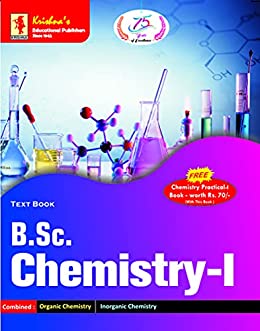
English | 2021 | ASIN: B097TJBK3L | 494 pages | PDF | 5.89 MB
SYLLABUS- B.Sc. CHEMISTRY-I,
INORGANIC CHEMISTRY-I
B.Sc. Ist Semester; Ist Paper
1. Atomic Structure: Dual nature of matter; de Broglie concept. Heisenberg uncertainty principle; its significance. Atomic orbitals, Schrödinger wave equation (no derivation); significance of and 2. Quantum numbers, radial and angular wave functions and probability distribution curves, shapes of s, p and d orbitals. Aufbau energy diagram, Pauli's exclusion principle. .
2. Periodic Properties: Atomic and ionic radii, ionization potential, electron affinity, electronegativity- definition, methods of determination/evaluation,
3.Redox Reactions-I: Displacement and redox reactions, oxidation state. Balancing of redox reactions (ion-electron and oxidation state methods). Computation of equivalent weights and concept of equivalence.
4.Chemical Bonding: Ionic bond, Covalent bond-valence bond theory and its limitations; directional nature of covalent bond; various types of hybridization and shapes of different inorganic molecules and ions.
ORGANIC CHEMISTRY-I
B.Sc. Ist Semester; IInd Paper
1.Structure and Bonding: Hybridization, bond lengths and bond angles, bond energy, localized and delocalized chemical bond, van der Waals interactions,
2. Mechanism of Organic Reactions: Curved arrow notation, drawing electron movements with arrows, half headed and double headed arrows, homolytic and heterolytic bond breaking. Types of reagents- electrophiles and nucleophiles. Types of organic reactions.
3.Stereochemistry of Organic Compounds: Concepts of isomerism. Types of isomerism. Optical isomerism- elements of symmetry, molecular chirality, enantiomers, stereogenic centers, optical activity, properties of enantiomers, chiral and achiral molecules with two stereogenic centres, diastereomers, threo and erythro diastereomers, meso compounds, resolution of enantiomers, inversion, retention and racemization. Relative and absolute configuration, sequence rules, D & L and R & S systems of nomenclature. Geometric isomerism; determination of configuration of geometric isomers, E & Z system of nomenclature, geometric isomerism in oximes and alicyclic compounds.
4. Alkanes and Cycloalkanes: IUPAC nomenclature of branched and unbranched alkanes, the alkyl group, classification of carbon atoms in alkanes. Isomerism in alkanes, sources, methods of formation (with special reference to Wurtz reaction,
PHYSICAL CHEMISTRY-I
B.Sc. Ist Semester; IIIrd Paper
1. Gaseous States: Postulates of kinetic theory of gases, deviation from ideal behaviour, van der Waal's equation of states, Critical phenomena" PV isotherms of real gases, e.
2. Liquid State: Intermolecular forces, structure of liquids (a qualitative description) Structural differences between solids, liquids and gases. Physical properties of liquids including their methods of determination: surface tension, viscosity and refractive index. Liquid crystals, difference between liquid crystal, solids and liquids.
3. Solid State: Definition of space lattice, unit cell, crystal planes, Miller indices, Laws of crystallography" (i) law of constancy of interfacial angels (ii) law of rationality of indices (iii) law of symmetry. Symmetry elements in crystals, X-ray diffraction by crystals,. Derivation of Bragg's equation. Determination of crystal structure of NaCl, KCl and CsCl (Laue's method and powder method).
4.Colloidal State: Definition of colloids, classification of colloids; Solids in liquids (sols): properties"kinetic, optional and electrical; stability of colloids, protective action, Hardy-Schulze law, gold number Liquids in liquids (emulsions) : types of emulsions, preparation, emulsifier, Liquids in solids (gels): classification, preparation and properties, inhibition, general application of colloids.
download скачать
https://nitroflare.com/view/0A9C6D092132B84/k3l6g.Krishnas..B.Sc..ChemistryI.Edition4th.pdf
https://rapidgator.net/file/9574cf8888aff7625cbdb85c4dcb7475/k3l6g.Krishnas..B.Sc..ChemistryI.Edition4th.pdf

